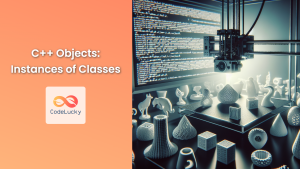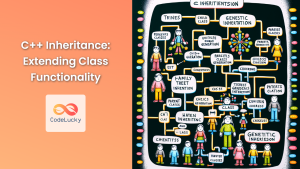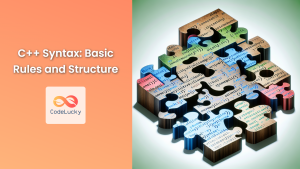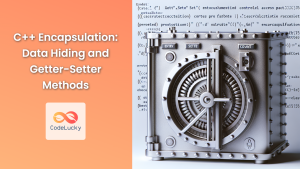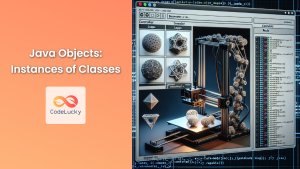In the world of C++, classes serve as the cornerstone of object-oriented programming. They act as blueprints for creating objects, encapsulating data and behavior into a single, cohesive unit. This article will delve deep into the intricacies of C++ classes, exploring their structure, functionality, and best practices for implementation.
Understanding C++ Classes
A class in C++ is a user-defined data type that encapsulates data and functions that operate on that data. It's a powerful concept that allows developers to create complex, reusable code structures.
Let's start with a simple example:
class Car {
private:
string brand;
int year;
public:
void setBrand(string b) {
brand = b;
}
string getBrand() {
return brand;
}
void setYear(int y) {
year = y;
}
int getYear() {
return year;
}
};
In this example, we've defined a Car class with two private data members (brand and year) and public methods to set and get these values.
Class Members
Classes in C++ can have two types of members:
- Data Members: Variables that hold data
- Member Functions: Functions that operate on the data
Data Members
Data members are the attributes of the class. In our Car example, brand and year are data members. They represent the state of the object.
🔒 Access Specifiers: Data members can be declared as private, protected, or public. It's a best practice to keep data members private to ensure encapsulation.
Member Functions
Member functions are methods that operate on the class data. In our example, setBrand(), getBrand(), setYear(), and getYear() are member functions.
🔧 Accessor and Mutator Functions: Functions that get and set the values of private data members are often called getters and setters, respectively.
Constructors and Destructors
Constructors and destructors are special member functions in C++ classes.
Constructors
Constructors initialize the object when it's created. They have the same name as the class and no return type.
class Car {
private:
string brand;
int year;
public:
Car() : brand("Unknown"), year(0) {} // Default constructor
Car(string b, int y) : brand(b), year(y) {} // Parameterized constructor
// ... other members ...
};
In this updated Car class, we've added two constructors:
- A default constructor that initializes
brandto "Unknown" andyearto 0. - A parameterized constructor that allows us to set the
brandandyearwhen creating a newCarobject.
Destructors
Destructors clean up resources when an object is destroyed. They have the same name as the class preceded by a tilde (~).
class Car {
public:
~Car() {
cout << "Car object destroyed" << endl;
}
// ... other members ...
};
This destructor will be called automatically when a Car object goes out of scope or is explicitly deleted.
Object Creation and Usage
Now that we've defined our Car class, let's see how we can create and use Car objects:
int main() {
Car myCar("Toyota", 2022);
cout << "My car is a " << myCar.getBrand() << " from " << myCar.getYear() << endl;
Car anotherCar;
anotherCar.setBrand("Honda");
anotherCar.setYear(2023);
cout << "Another car is a " << anotherCar.getBrand() << " from " << anotherCar.getYear() << endl;
return 0;
}
This code will output:
My car is a Toyota from 2022
Another car is a Honda from 2023
Static Members
C++ classes can also have static members, which belong to the class rather than to any specific object.
Static Data Members
Static data members are shared by all objects of the class. They're declared in the class definition and defined outside the class.
class Car {
private:
static int totalCars;
public:
Car() {
totalCars++;
}
static int getTotalCars() {
return totalCars;
}
// ... other members ...
};
int Car::totalCars = 0; // Definition of static member
Static Member Functions
Static member functions can be called without creating an object of the class. They can only access static data members directly.
int main() {
Car car1, car2, car3;
cout << "Total cars: " << Car::getTotalCars() << endl; // Outputs: Total cars: 3
return 0;
}
Inheritance
Inheritance is a fundamental concept in object-oriented programming that allows a class to inherit properties and methods from another class.
class ElectricCar : public Car {
private:
int batteryCapacity;
public:
ElectricCar(string b, int y, int bc) : Car(b, y), batteryCapacity(bc) {}
int getBatteryCapacity() {
return batteryCapacity;
}
};
In this example, ElectricCar inherits from Car and adds a new property batteryCapacity.
Polymorphism
Polymorphism allows objects of different classes to be treated as objects of a common base class.
class Vehicle {
public:
virtual void start() {
cout << "Vehicle started" << endl;
}
};
class Car : public Vehicle {
public:
void start() override {
cout << "Car started" << endl;
}
};
class Motorcycle : public Vehicle {
public:
void start() override {
cout << "Motorcycle started" << endl;
}
};
int main() {
Vehicle* v1 = new Car();
Vehicle* v2 = new Motorcycle();
v1->start(); // Outputs: Car started
v2->start(); // Outputs: Motorcycle started
delete v1;
delete v2;
return 0;
}
This example demonstrates polymorphism through the use of virtual functions.
Friend Functions and Classes
Friend functions and classes have access to private and protected members of a class.
class Car {
private:
int price;
public:
Car(int p) : price(p) {}
friend void displayPrice(Car& c);
friend class Dealership;
};
void displayPrice(Car& c) {
cout << "Price: $" << c.price << endl;
}
class Dealership {
public:
void adjustPrice(Car& c, int adjustment) {
c.price += adjustment;
}
};
In this example, displayPrice is a friend function, and Dealership is a friend class of Car.
Operator Overloading
C++ allows you to redefine the behavior of operators for user-defined types.
class Complex {
private:
double real, imag;
public:
Complex(double r = 0, double i = 0) : real(r), imag(i) {}
Complex operator+(const Complex& c) {
return Complex(real + c.real, imag + c.imag);
}
void display() {
cout << real << " + " << imag << "i" << endl;
}
};
int main() {
Complex c1(3, 2), c2(1, 7);
Complex c3 = c1 + c2;
c3.display(); // Outputs: 4 + 9i
return 0;
}
This example demonstrates how to overload the + operator for a Complex number class.
Best Practices for C++ Classes
- 🛡️ Encapsulation: Keep data members private and provide public methods to access and modify them.
- 🏗️ RAII (Resource Acquisition Is Initialization): Use constructors to acquire resources and destructors to release them.
- 🔄 Rule of Three/Five: If you define a destructor, copy constructor, or copy assignment operator, you should probably define all three (and consider move semantics for C++11 and later).
- 📏 Single Responsibility Principle: A class should have only one reason to change.
- 🧩 Composition over Inheritance: Favor object composition over class inheritance when designing larger systems.
Conclusion
C++ classes are a powerful tool for creating structured, maintainable, and reusable code. They form the foundation of object-oriented programming in C++, allowing developers to model real-world entities and concepts in their programs. By mastering the intricacies of classes, including constructors, destructors, inheritance, polymorphism, and the various member types, you'll be well-equipped to design robust and efficient C++ applications.
Remember, the journey to becoming proficient with C++ classes is ongoing. Practice, experiment, and continue to explore more advanced concepts to truly harness the power of object-oriented programming in C++.

